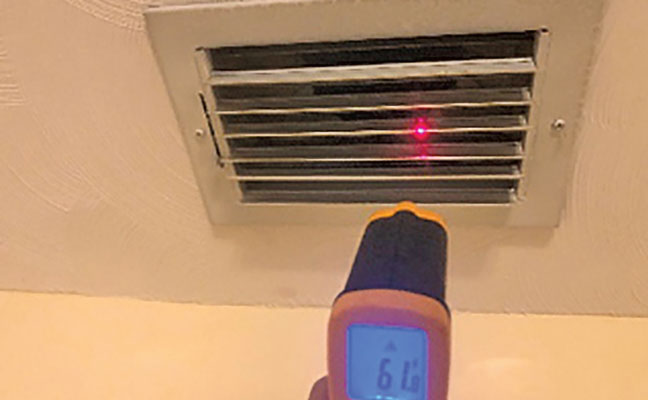
If you can see light during the day in door seals and slab cracks, pests can gain entry. Look for ants, millipedes, beetles and other pests in these locations; they may be looking for shelter or foraging for food. PHOTO: MATT REMMEN
Microclimates are important. In addition to regulating temperature, they regulate humidity and generally make a better place for pests to live. Temperature, moisture and building methods will vary, but your deductive reasoning will not.
INSIDE RESIDENTIAL STRUCTURES
Many of the pests found inside homes use dark and cool spaces with low or no air movement. Inside structures, you are likely to find vastly different temperatures, entry points, food sources and availability of harborages. Focus on finding these features, and your chances of controlling the pest rise drastically. Consider the following:
-

Look here for gaps or moisture. PHOTO: MATT REMMEN
Mind the gaps: Expansion joints and cracks and crevices in garage floors, for example, may allow for movement of the structure with changes in temperature and season, allowing pests to enter the property. The gaps in doors and entryways are also ideal for pest entry and frequently require maintenance. You also can diagnose an issue by looking for gaps as well as mold or mildew. When you see an air conditioner register with a bit of mold or mildew, you may have an air leak where moisture is accumulating. While we may not be building repair experts, this is a huge clue if you have cryptic pest sightings.
- Attics: Though it may not appear inviting, an attic can be a great place for pests to live no matter the season. Many pests seem to prefer mild to moderate temperatures, and the dark spaces and lack of airflow in attics help mitigate the high temperatures. The difference in temperature between an attic and the space between the ceiling and the top of the insulation can be 30 degrees Fahrenheit or more. Also, penetrations such as bathroom and kitchen exhaust fans provide an outflow of air — and may also have large enough cracks and cervices to allow many pests entry into the home. If you have a pest issue like carpenter ants in one of these areas and you haven’t checked above the ceiling, you may be missing the satellite colony.
- Harborage areas: Not all pests are looking to penetrate the structure via cracks or crevices. Instead, some pests, such as cockroaches, may be living alongside your customer within their own microclimate.
For example, bathroom escutcheons look nice, but they don’t really exclude cockroaches. Bathrooms and kitchens have the added benefit of water in both liquid and vapor form. It does not take much moisture to make an area habitable for cockroaches.
Take time to inspect indoor harborage areas, as some areas may have old bait from previous applications that needs to be scraped away. In general, there is not an area inside most residential locations that is too hot for cockroaches. As you can see even below, even the bottom of a running dishwasher is fairly cool mid-cycle.

From left are the temperatures in degrees Fahrenheit for below insulation, the backside of roof sheathing, and a bathroom vent. Notice the temperature differential at the vent vs. the underside of the insulation is 24 degrees. Combine that with a likely difference in humidity, and you have an ideal spot for a bit of moisture to accumulate and protect pests, especially ants. Don’t forget about the kitchen vent as well. PHOTO: MATT REMMEN

Use your knowledge of pest needs to identify areas most likely for pest presence and apply the right formulations to gain the highest likelihood of control. PHOTO: MATT REMMEN
OUTSIDE RESIDENTIAL STRUCTURES

Protect the pest control products stored in your work vehicle, because sunlight and heat can degrade them. Don’t leave bait exposed in places with direct sunlight. Check out the nearly 140-degree Fahrenheit temperature of the exterior of a car on a hot day, below. Consider storing baits in a small cooler or in the shade to minimize degradation. PHOTO: MATT REMMEN
Hot surfaces outside are not ideal for most insects, and they generally avoid them in the middle of the day. However, sometimes products are applied in areas that are too hot. When pest management professionals (PMPs) don’t see insects rushing to feed on baits, for example, this often leads to questions about bait efficacy. The reality is, the problem is likely the timing of bait placement, not its efficacy or attractiveness.
All mulch in full sun is hot, even different textured mulches such as shredded vs. bark. Shaded areas stay cooler, but will vary as the sun moves across the surface. For example, when we took the digital temperatures of pine bark mulch at the base of a partially shaded shrub, it was 96 degrees Fahrenheit, In full shade it was 90 degrees Fahrenheit, and in full sun it was 116 degrees Fahrenheit — a full 26-degree difference.
If a product cannot be directly applied to trailing pests, incorporation of an appropriately formulated product into mulched areas may help reduce degradation from heat and/or sunlight. The takeaway here is to bait in areas that are protected, use stations to protect bait, and bait when there is a high likelihood of pest activity.

A temperature reading of pine bark mulch near a shrub in full shade. PHOTO: MATT REMMEN
When treating with residual products (liquid or granules):
- Rake back mulch, apply the product, and recover with mulch.
- Treat cracks, crevices, roots and similar items that serve as guidelines for pests to travel.
- Treat shaded areas where pests would likely harbor during the harshest part of the day.
With these tactics, you should be able to locate and troubleshoot the most likely places insects can enter or find harborage within a residential structure. Keeping temperature, humidity and time of day in mind when solving pest issues will enhance your efficacy as a pest management professional.
Leave A Comment